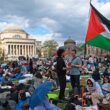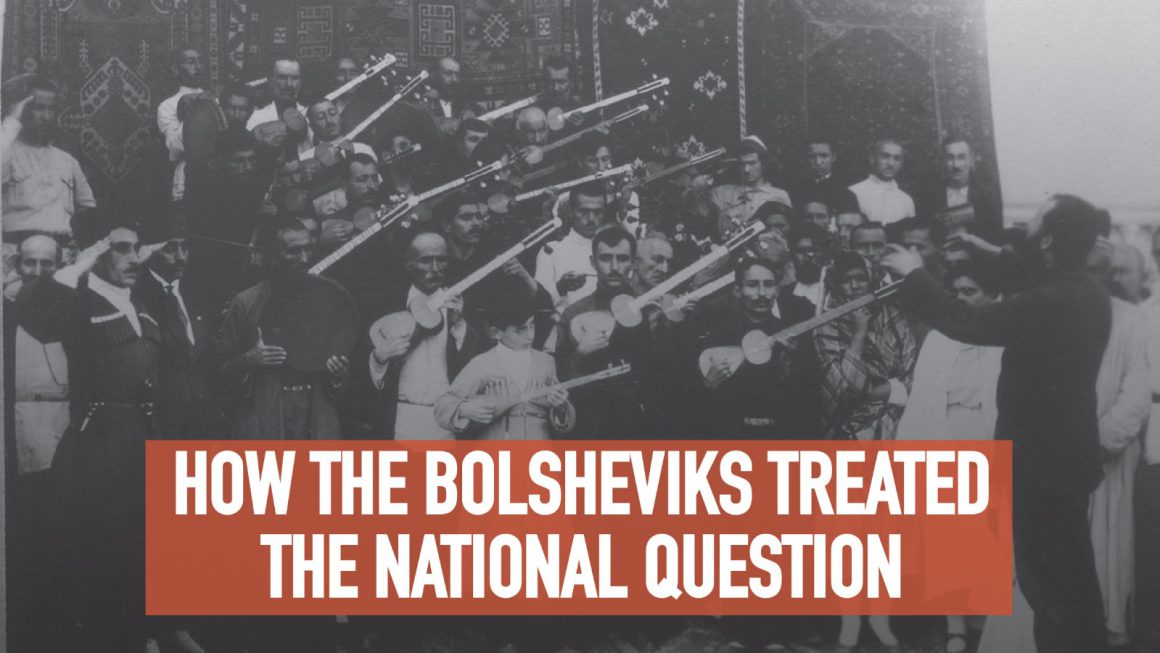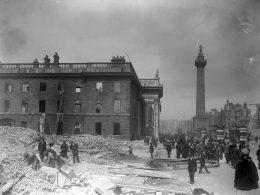Rob Jones, Sotsialisticheskaya Alternativa (Our sister organisation in Russia)
A century after the October revolution, the approach of the Bolsheviks to resolving the national question remains a shining example of what could be achieved in resolving national conflicts if genuine socialist governments were to come to power across the world.
This is particularly the case when, under capitalist domination, the world in the 21st century has been ravaged by murderous conflicts in Darfur, the Congo, the Middle East. The national question has still not been satisfactorily resolved in Catalonia, Scotland, Ireland, Belgium and elsewhere and has fueled brutal conflicts in the Balkans, Caucasia, Central Asia and Ukraine.
Two brutal wars in Chechnya and the treatment of national minorities demonstrate that the ruling elite in modern capitalist Russia has nothing in common with the Bolsheviks. The recent attack in Surgut, the Siberian oil town, when a young Muslim run amok with a knife in a shopping centre is clearly the result of racist state policies and the actions of far-right extremists. Only recently riot police invaded a café in the town and forced young men there to shave their beards, claiming they could be Wahhabis. The Bolsheviks however, led by Lenin bent over backwards to support the rights of national and ethnic minorities. Way ahead of his time, Lenin even criticized the use in everyday language of national stereotypes such as the use of the word “Khokhol” to describe Ukrainians. Not only is this word still in widespread use, it was added to recently by official Russian propaganda which presented the Ukraine as a fascist state.
The language question
The Bolsheviks were very sensitive to the language question, taking conscious steps to support the use of minority languages. Lenin spoke against the recognition of specific languages as “state languages”, particularly when that meant that significant language minorities were discriminated against. Yet in complete contrast to this approach, the attempts by the new capitalist governments to restrict the use of the Russian language led to serious ethnic conflict in Moldova in the 1990s and serious tensions in the Baltic states. In President Nazarbayev’s Kazakhstan, whenever social conflict has arisen, in particular during the Zhenaozen oil workers’ strike, he has leant on the so-called “National-patriots” and “National-democrats” (right-wing nationalists) to call for restrictions on the Russian language. Even the threat of restricting the use of Russian in Ukraine was enough to heighten the tensions that led to the conflict in East Ukraine. Hypocritically, the Putin government, which used the attack on the rights of Russian speakers in Ukraine to intervene in East Ukraine has now announced that finance for the teaching of Russia’s many minority languages will cease. This is already causing discontent in republics such as Tatarstan.
Declaration on the Rights of the peoples of Russia*
Most of all, the Bolsheviks were principled proponents of the right of nations to self-determination. Within days of the October revolution, the Declaration on the Rights of the peoples of Russia was published. In contrast to the approach of modern diplomacy, in which different sides maneuver and disguise their real intent from the population, this revolutionary declaration stated in a clear, transparent and concise way that because the peoples of Russia have suffered such repression and misrule, freedom from pogroms, slavery and attacks should be immediately granted, decisively and irreversibly. There should be, it declared, the equality and sovereignty of the Russian nationalities, the right of the Russian peoples to self-determination up to and including the right to form their own states, the abolition of all and any national and religious privileges and restrictions supported by the free development of national minorities and ethnic groups populating Russian territory.
The Provisional government
In itself, this was a real contrast to the position adopted by the different governments that ruled Russia following the February 1917 revolution. The spontaneous and popular uprising that overthrew Tsarist authoritarianism in February was driven by the worker, soldier and peasant masses who believed that, as a result, there would be a free and democratic society established in Russia — many believed it would lead to a socialist society. But reality was starkly different. Not only did the new bourgeois coalition refuse to end Russia’s participation in the First World War or grant land to the peasantry, it refused to grant the numerous peoples and nations of the former Tsarist empire freedom. As early as March, for example, it sent an order to Finland confirming its status as part of the Russian empire as defined by the former Tsar in the 18th century. When in July the Finnish Sejm passed a resolution stating that it alone “decides, affirms, and decrees on the implementation of all Finnish laws, among them those dealing with finances, taxation, and customs” the Provisional Government sent troops to disband the parliament. The issues of the rights of the Russian peoples, the Provisional Government decreed, would be decided by the Constituent assembly. But when it eventually published the position on the rights of nations to present to the Constituent Assembly, it stated quite bluntly that it considered the “Russian state to be one and indivisible”.
Bolsheviks granted right to self-determination
Whilst the “bourgeois democracy” that ruled Russia from February to October implied that the new “democracy’ would include freedom for the various nations and peoples but failed to deliver on its promises, the new Soviet government led by the Bolsheviks not only declared but did all it could to implement the right of self-determination. It took less than a week for the new Soviet government to recognize Finland’s right to independence. This was quickly followed by support for the independence of Ukraine, Moldova, Lithuania, Estonia, Transcaucasia, Belarus, Poland and Latvia. Notwithstanding all the complexities and difficulties, and that in general, these new independent countries were bourgeois nationalist rather than Soviet, the Bolshevik government respected these rights.
Central Asia, the focus of the imperialist “Great game” had, by 1917, barely emerged from a form of feudalism. Although part of the Tsarist empire, it was ruled by a series of feudal Khans with no consolidated nations. A working class barely existed, at best it was made up of the railway and support infrastructure workers, most of whom were Russian and Russian speaking. Local elites had, for many decades, been forced to submit to the Tsarist dictates backed by armed force, so they saw the revolution as an opportunity to escape from Russian domination. Whilst doing all it could to encourage the development of a socialist consciousness and soviet democracy in this region, the Bolsheviks recognized reality as it then was, and bent over backwards to demonstrate good-will to the different nationalities.
The Khan of Khorezm (in an area now covered by Turkmenistan) remained in power until 1920 when he was overthrown by a popular uprising supported by Red Army troops. The new Russian Socialist Federation recognized the Khorezm People’s Soviet Republic as an independent state –publicly renouncing all claims to territory and offering a voluntary economic and military union with the new state. All property and land that once belonged to the Russian state, as well as administrative structures were handed over to the new government with no demands for compensation. Financial assistance was provided to build schools, to campaign to end illiteracy and to build canals, roads and a telegraph system.
Poland
At the other end of the huge former Tsarist empire was Poland. For over a hundred years before 1917 it had been partitioned under the control of the Austrian, Prussian and Russian empires. As these empires collapsed at the end of the war, and the Russian revolution spread over all the territories of the former Tsarist empire, Poland found itself in in a new situation — able to unify and claim independence. The Bolshevik government recognized the Polish National Committee as representatives of Poland.
The new Polish provisional government led by Pilsudski — then a leader of the Polish Socialist Party — under pressure of the masses introduced the 8-hour day, votes for women and free school education. Pilsudski however announced that he “got off the Socialist street car at the stop called Independence.” The new government moved against the soviets and workers councils that had sprung up, arresting communists and used the opportunity of the civil war raging in Russia to expand Polish territory. Polish troops invaded Lithuania and, backed by the western powers, formed an alliance with the Ukrainian nationalist Petlura and moved into Ukraine, eventually seizing Kiev. It took a decisive counter-attack by the Red Army to force them back to Warsaw. Notwithstanding this, Lenin insisted, during the peace negotiations with Poland, that “the policy of the Russian Socialist Federation with regards to Poland is based, not on temporary military or diplomatic advantages but on the absolute and unbreakable right to self-determination. The RSFSR recognizes and recognizes unconditionally the independence and sovereignty of the Republic of Poland, and recognizes this from the moment when the Polish state was formed”.
Lenin’s struggle
Lenin fought hard to ensure that the “right of nations to self determination” was included in the program of the Bolshevik party. His disagreements with Rosa Luxembourg who believed that such a demand was a diversion from class struggle are well known. Her arguments were mirrored by leading Bolsheviks such as Karl Radek, Yuri Pyatokov and Nikolai Bukharin.
As part of the polemic on this question, Lenin encouraged Stalin to write his pamphlet on the national question although he found it necessary to oppose elements of Stalin’s approach even at this early stage. He did not agree with Stalin’s rigid definition of a nation as ‘historically constituted, stable community of people, formed on the basis of a common language, territory, economic life, and psychological make-up manifested in a common culture’, which would have ruled out the rights of many peoples, most notably the Jews. Nor did Lenin agree with the position proposed by Stalin and Bukharin in 1919 which called for the right of self-determination for the working class of each nation. He argued that as many of the peoples found in the Russian empire — including the Kuvash, Bashkir, Turkmen, Kyrghiz and Uzbek peoples — lived in areas that were still socially and economically undeveloped, they as yet had no chance to develop even classes let alone class consciousness. Yet as early as 1918 Stalin was arguing that “the slogan of self-determination is outmoded and should be subordinated to the principles of socialism”. By October 1920 he said calls for the secession of the border regions from Russia “must be rejected not only because they run counter to the very formulation of the question of establishing a union between the centre and the border regions, but primarily because it runs fundamentally counter to the interests of the mass of the people in both the centre and border regions.”
Ukraine
Unfortunately, Stalin was not alone in holding this position. When the February revolution broke out, the number of Bolsheviks in Kiev, the capital and industrial centre of Ukraine was just 200, and they were barely organized. By October their number reached 800. In response to February, the leaders of the Ukrainian bourgeoisie established the Tsentralnaya rada (Central soviet) as “a government of all Ukrainians” and claimed its right to self-determination. The leaders of the Kiev Bolsheviks, however, did not recognize the importance of the national question, saying it was a secondary to that of class struggle. While participating in the general all-Russian struggles against the provisional government in Petrograd, they left the Tsentralnaya rada to continue its nation building — including the establishment of government structures and armed forces. After October, they participated in a block together with Mensheviks and Bundists, which recognized the “Tsentralnaya rada as the legitimate government and declared that any opposition to it should be “exclusively of a peaceful form”. They refused to accept the position of other Ukrainian Bolsheviks that it “was necessary to wage an uncompromising struggle against the rada and, on no account to make any agreements with it”. As a consequence, the Tsentralnaya rada maintained a strong position as a government in Ukraine and the Soviet takeover was delayed and significantly weakened — thus making the civil war in Ukraine much more complex and prolonged than would have been the case if the Kiev Bolsheviks had acted decisively.
National question and the Red army
Notwithstanding the difficulties in Ukraine, Lenin’s approach played a critical role in ensuring the victory of the Soviets in the Civil war, not least because most of the White Guard armies opposed self-determination in any form.
In the Caucasus, White General Deniken made clear that he opposed national rights because “Russia should be one and indivisible”. Even nationalist groupings who were opposed to the Bolsheviks in general viewed the promise of self-determination as a good enough reason to at least maintain neutrality. In many cases, the promise was enough to win over whole nationalities.
One critical decision related to the decision to base the Red Army on territorial units on the basis “you serve where you live”. The old Tsarist army was Russified — in those cases when members of national minorities served, they were, with the exception of the Cossacks, sent into regular units away from their own home, and expected to speak Russian. But the Red army under Trotsky had a different approach. Whole units of the Red Army were based on the various nationalities using their own language and with many military publications in the non-Russian languages. This helped the Red Army win over the populations of those areas where other nationalities dominated. Many Jewish groups set their own units up in opposition to the pogroms initiated by General Kolchak and others. A school of Muslim Red Army officers was even established in Kazan, the capital of Tatarstan. In 1919 the whole national army of Bashkiria, a Muslim region stretching from the Volga to the Urals, joined up with the Red Army and established the Bashkir Soviet Socialist Republic.
Wherever they were established, such national formations were given huge material assistance in the sphere of education and health, in particular, in the campaign to end illiteracy. Despite the civil war, the number of universities in the new socialist country grew from 63 in 1917 to 248 in 1923. While avoiding a headlong clash with proponents of the Muslim religion, active agitation was conducted against polygamy, the sale of brides and the practice of allowing divorces only if the husband agreed. Unfortunately, this approach was one of the victims of the rise of Stalinism, which by the 1930s had reintroduced the Russian language as the command language and stopped military publications in other languages.
Mistakes were made
Maintaining the sensitive and flexible approach to the different nationalities required many discussions and often the need for direct interventions by Lenin or his supporters to correct mistakes. While the Bolsheviks were in favor of the voluntary collectivization of land, Lenin warned that in regions, such as Central Asia and the Caucasus, it would be premature to push the issue. He even argued against the nationalization of the oil industry in Azerbaijan fearing that, as the working class were not yet developed enough it would lead to the disruption of supplies during the civil war.
In some areas, notwithstanding Lenin’s approach, the nationalities were treated clumsily. The Bolshevik revolution had barely reached Central Asia before the local intellectuals and national elites saw the opportunity to develop autonomy or even new national republics. But the revolution arrived through the railway workers and disbanded troops, almost all of whom were Russian speakers. They established the Tashkent Soviet of Workers and Soldiers deputies and declared ‘Soviet Power’. They argued that Muslims should not maintain positions in the new states and that there was no need to include peasants in the Soviet because of their ‘backwardness’. Consequently, the Soviet found itself isolated from 95% of the local population. Its attempt to use military force to overthrow the new Kokland government, which argued for the setting up of a “democratic federal republic of Turkestan as part of the Russian Federation”, backfired as many saw this as simply a military occupation.
Lenin’s flexible approach
Initially the attitude of Stalin’s Ministry of Nationalities was that this was a local matter, but as the White Armies were defeated in the region, the question of how Soviet power was to be established became more urgent. Frunze, who headed the Red army’s advance, originally proposed breaking the region up to make it easier to rule. This met with resistance from local communists, many of whom barely grasped the basic principles of Bolshevik policies. But they were even more upset when Stalin headed a commission to propose the setting up of a unified Turkestan Autonomous region as part of the Russian Federation. Eventually Lenin had to step in and redefined the position to be adopted: care should be taken to equalize the land tenure of Russians with locals while reducing the influence of Russian kulaks energetically; to ensure that any decisions taken centrally about Turkestan should be made only with the consent of local leaders; to systematically, “gradually but steadily”, prepare for the transfer of power to the local Soviets of working people with the general task defined as “not Communism, but the overthrow of feudalism”. Any decision, he said on “the question of dividing the Republic into three parts should not be decided prematurely”.
Korenization
Other questions that took up much time and energy to resolve related to “korenization”(“koren” means root), which is the principle that the Bolsheviks put down roots in the new republics and ethnic areas by developing local leaderships rather than relying on emissaries from the center.
Particular attention was paid to the development of national cultures, in particular, languages. Lenin would get quite angry when he heard that soviet officials, including those from the centre, continued to use Russian in those areas where Russian was not the local language: “Soviet power differs from every bourgeois and monarchical power in that it represents the real daily interests of the laboring masses in full measure, but that is only possible on the condition that soviet institutions work in the native languages”. Unfortunately, one of the worst barriers to the development of national languages was the Nationalities ministry itself, whose officials often argued that it was sufficient to just translate from Russian into local languages. Lenin replied that, on the contrary, the task was to ensure that educational authorities provide teachers familiar with native languages and cultures as well as native language textbooks. At a Congress discussing this issue, one speaker argued that “An international spirit is not achieved by lumping together children who cannot understand each other, but rather by introducing in the native tongue the spirit of world-wide revolution”.
To assist in building support in the non-Russian areas, the Bolsheviks adopted a conscious policy of working with and attempting to win over left revolutionary organizations. In Ukraine, much effort was spent and much patience was needed to work with the “Borotba” organization, essentially a left-social revolutionary grouping with roots in the countryside. Christian Rakovskii, a long time friend and ally of Trotsky, played a key role in this work. At the same time, ten new “communist universities” were established to train national Bolshevik cadres. As importantly, a huge investment was made in opening the public education system for teaching in the national languages. Ten million rubles were allocated in 1921 to further the teaching of Belarussian and Ukrainian languages. This process was completed quickly for major nationalities such as Armenian, Georgian and Azeri. Smaller nationalities took longer. But the task was treated seriously. By 1923 there were 67 schools teaching in Mari, 57 in Kabardi, 159 in Komi, 51 in Kalmyk, 100 in Kirghiz, 303 in Buriat and over 2500 for the Tatar language. In Central Asia, the number of national schools, which numbered just 300 before the revolution, reached 2100 by the end of 1920. This is of particular significance as many of the languages/dialects in the region were, until the revolution, unwritten. The introduction of new alphabets, often latinized, together with the modernization of the Russian alphabet, assisted this task.
This achievement is all the more impressive given that the civil war raged for most of this period. Often this meant a lack of resources. Schools were often used to billet troops. And as many willing teachers were involved in the war effort, it was often difficult to find enough to teach in the schools. In Ukraine, there were very few Ukrainian language teachers in 1917, and although by 1923 there were already 45000, twice this number was needed. The situation improved dramatically after the end of the civil war.
Caucasia
Without Lenin’s sensitive and flexible approach to the national question, winning the civil war would have been much more difficult.
Unfortunately, this approach became one of the first victims of the bureaucratic degeneration of the revolution that gathered strength in the early twenties, with the issue coming to a head in the Caucasus.
The Caucasian regions, primarily Georgia, Azerbaijan and Armenia, waited in vain for the February revolution to recognize self-determination and when the October revolution took place, they found themselves occupied by a combination of German and Turkish armies. Following the German defeat in 1918, their place was taken by the British and Denikin’s White Army. Indeed, by signing the Brest-Litovsk peace, not only did the Bolsheviks cede control of the Baltics and significant parts of Ukraine and Belarus but they also accepted that a significant part of the Caucasus was conceded to the Ottoman Turks.
As the civil war progressed and Denikin’s forces were pushed back eventually to the Crimea, the question was posed as to who should govern the Caucasus. The Bolsheviks had significant support in the large towns, such as Baku in Azerbaijan, Tbilisi in Georgia, Groznii in Chechnya. Essentially the revolution reached the region through the military victory of the Red Army. Soviet republics were established in Azerbaijan and Armenia.
Georgia, however, was the stronghold of a Menshevik government, a sort of cause-celebre for the reformist Second International. Despite harsh political polemics with the Georgian leaders, several of whom had been involved in the 1917 Provisional government in St Petersburg, Lenin favored a conciliatory policy. Trotsky too argued against military intervention — the task of overthrowing the Georgian government should be carried out by the Georgian people, he believed. He therefore favored “a certain preparatory period of work inside Georgia, in order to develop the uprising and later come to its aid.” In May 1920, the Russian Soviet Government signed a treaty recognizing Independence and agreeing a non-aggression pact.
Stalin’s inflexibility
The leading representative of the Bolsheviks in the region, Sergey Ordzhonikdze, a close comrade of Stalin (they were both Georgians) had other ideas. After the establishment of a Soviet Azerbaijan and Soviet Armenia, he argued for the immediate Sovietization of Georgia. Stalin backed this position. Ignoring the recommendations of Lenin and the Russian government, they used the Red Army units to provoke clashes on the Georgian border. The Central Committee, presented with a fait-accompli, was forced to pass a resolution saying it was “inclined to allow the 11th Army to give active support to the uprising in Georgia and to occupy Tiflis provided that international norms are observed, and on condition that all members of the Military Revolutionary Council of the Eleventh Army, after a thorough review of all information, guarantee success. We give warning that we are having to go without bread for want of transport and that we shall therefore not let you have a single locomotive or railway track. We are compelled to transport nothing from the Caucasus but grain and oil.” This information was kept secret from Trotsky, then in the Urals. On his return to Moscow, he was so furious to discover what had happened, he demanded a Commission of Enquiry investigate why the Red Army had intervened in this way.
The intervention naturally aroused opposition from the local population and a significant layer of Georgian Bolsheviks. But rather than recognize the long-term national sensibilities in the region, in which there were clearly three well established national identities, Ordzhonikidze, with Stalin’s backing, engineered the establishment of a “Transcaucasian Soviet Republic”, which would be part of the RSFSR and have overall authority over the three new Soviet republics. Apart from being able to rule on Georgian domestic issues, it also attempted to establish a currency union, which was opposed by the Georgians who believed such a union would undermine their relatively stronger economy. Given this approach in establishing the Transcaucasian Soviet Republic, many also assumed that the economy would be developed by importing a Russian workforce, which many in the area saw as a continuation of former Tsarist practices.
Of course, Ordzhonikidze’s heavy-handed approach in which he made decisions often without consulting local leaders, his use of harsh repressive measures against opponents and his extravagant lifestyle, including his riding of a large white horse, did little to ease the tensions.
Formation of the USSR
The discussion around the Transcaucasian Soviet Republic was part of a wider question of the future of the new Soviet state.
By this time, it had become clear that the positions of Lenin and Stalin on the national question were diametrically opposed. The former saw the formation of a union of free and equal Soviet states as a means of consolidating support for the revolution amongst the different nationalities and as a basis for allowing future Soviet states, such as Germany, to ally with Russia without any one power dominating the other. Stalin, however, believed that the national question was secondary and moreover, that the revolution would not spread and socialism would need to be built in Russia alone. For him, the existence of republics, such as the Transcaucasian republic, was for administrative convenience. The issue came to a head with the discussion around the formation of the USSR.
As Commissar for the Nationalities, Stalin drafted the original document which was to decide the relationships between the new Soviet republics. In the draft, he proposed that the independent Soviet republics of Ukraine, Belarus, Georgia, Azerbaijan and Armenia be established as autonomous regions within the Russian Federation, with the status of Bukhara, Khorezm and the Far East to be decided later. For all key functions such as the economy, budget, foreign and military affairs, decisions would be taken by the Russian ministries. Only relatively minor issues such as culture, justice, healthcare and land would remain the responsibility of the “autonomous” regions. All the republics, with the exception of Azerbaijan, objected vociferously to this plan. Yet Stalin pushed his plan through the special mission established to approve the proposal, before submission to the government.
But he had one more barrier to overcome — Lenin. During a remission from the consequences of his stroke, Lenin was shown the proposal. He reacted very angrily and insisted that the whole idea of “autonomy” as proposed by Stalin be dropped and that the USSR should be established as a federation of equal republics. Although Stalin was forced to concede this point, he fought to ensure the new USSR would not go so far as to assure the national rights Lenin wanted. He changed his earlier position of opposition to a two-tier power structure for the new Union by introducing a new “Council of nationalities” above the legislature. He packed this Council with his own supporters. And to add insult to injury, rather than give the three Caucasian republics Union status, he proposed that the “Transcaucasian soviet republic” should join the USSR and the three republics submit to this body. This approach infuriated the Georgians.
Lenin’s anger
Lenin was too ill to attend the Central Committee meeting that discussed these proposals in February 1923. When he eventually received a report, Lenin’s anger reached boiling point. He wrote to Trotsky: “Comrade Trotsky! I would very much like to ask you to take upon yourself the defense of the Georgian case in the Central Committee of the party. The matter is now being “prosecuted” by Stalin and Derzhinskii, on whose objectivity I cannot rely”.
Although not Lenin’s final word on the question, his health was deteriorating quickly. He was unable to attend the closed meeting of the Central Committee in June, which was devoted to a full discussion of the national question. The conflicting positions put by speakers at this meeting showed in clear outline the developing contradictions between those who supported Lenin’s approach to the nationalities and those around Stalin who rejected all the main tenets of the Bolshevik position. Unfortunately, although Lenin’s proposal of establishing the USSR was adopted, its implementation was left in the hands of the rapidly crystallizing bureaucratic caste around Stalin.
Crimes of Stalinism
Unfortunately, the approach to the national question of the Stalinist bureaucracy, which managed to complete the political counter revolution in the USSR following Lenin’s death, turned the national policies of Lenin and the Bolsheviks on their head. The damage caused by the Great-Russian chauvinism that Lenin so bitterly criticized combined with the bureaucracy’s anti-semitism and racist outlook was compounded by the criminal policy of forced collectivization which led to famine across wide areas of Russia, Ukraine and Central Asia. This allows today’s reactionary nationalists to claim that there was a conscious policy of genocide, which they call “holodomor” against the nationalities, blaming it on ‘Bolshevism’. The use of the Baltic states as pawns in negotiations with Hitler, the deportation of whole nations, including the Chechens and Crimean Tartars to Kazakhstan during the second world war, the use of the Soviet army to put down uprisings in the former East Germany, Hungary and Czechoslovakia and the refusal to recognize nation rights during the period of “perestroika” had absolutely nothing in common with the national policy of Lenin and the Bolshevik party.
A hundred years later, Lenin’s policy on the national question has even more relevance than before.
It is a fatal mistake to adopt, as some of the modern left do, Stalin’s position that “the slogan of self-determination is outmoded and should be subordinated to the principles of socialism”. As long as capitalism exists, no nation can gain genuine independence, as it will always be dominated by the interests of the multi-national companies and different imperialist interests, nor is it capable of ensuring genuine democratic and national rights for all. To overthrow the capitalist system requires a powerful, united working class struggle with a socialist leadership, the building of which will only be possible if it has a clear position on the national question.
*What does “Russian” mean?
In the Russian language, there are two words for Russian.“Russkiy” refers to the ethnicity Russian, while “Rossiskiy” refers to anyone living in Russia. Under the Tsar, the country was the ‘Russkiy empire’, under the Bolsheviks, it was the ‘Rossiskaya Soviet Federation of Socialist Republics’. The “peoples of Russia” refers to all the nationalities living in Russia.












